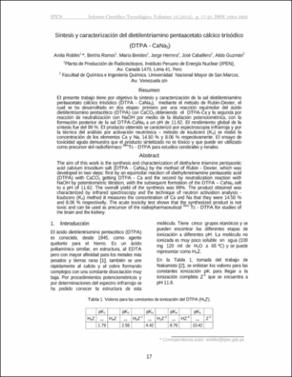Mostrar el registro sencillo del ítem
Síntesis y caracterización del dietilentriamino pentaacetato cálcico trisódico (DTPA - CaNa3)
| dc.contributor.author | Robles, Anita | |
| dc.contributor.author | Ramos, Bertha | |
| dc.contributor.author | Benites, María | |
| dc.contributor.author | Herrera, Jorge | |
| dc.contributor.author | Caballero, José | |
| dc.contributor.author | Guzmán, Aldo | |
| dc.creator | Caballero, José | |
| dc.creator | Guzmán, Aldo | |
| dc.creator | Ramos, Bertha | |
| dc.creator | Herrera, Jorge | |
| dc.creator | Robles, Anita | |
| dc.creator | Benites, María | |
| dc.date.accessioned | 2014-04-24T19:07:14Z | |
| dc.date.available | 2014-04-24T19:07:14Z | |
| dc.date.issued | 2014-01 | |
| dc.identifier.citation | Robles A, Ramos B, Benites M, Herrera J, Caballero J, Guzmán A. Síntesis y caracterización del dietilentriamino pentaacetato cálcico trisódico (DTPA - CaNa3). Informe Científico Tecnológico. 2012; Volumen 12, p. 17-21. | es_PE |
| dc.identifier.issn | 1684-1662 | |
| dc.identifier.uri | https://hdl.handle.net/20.500.13054/125 | |
| dc.description.abstract | El presente trabajo tiene por objetivo la síntesis y caracterización de la sal dietilentriamino pentaacetato cálcico trisódico (DTPA - CaNa3), mediante el método de Rubin-Dexter, el cual se ha desarrollado en dos etapas: primero por una reacción equimolar del ácido dietilentriamino pentacético (DTPA) con CaCO3 obteniendo el DTPA-Ca y la segunda por reacción de neutralización con NaOH por medio de la titulación potenciométrica, con la formación posterior de la sal DTPA-CaNa3 a un pH de 11.62. El rendimiento global de la síntesis fue del 99 %. El producto obtenido se caracterizó por espectroscopia infrarroja y por la técnica del análisis por activación neutrónica – método de ksubcero (K0) se midió la concentración de los elementos Ca y Na, 14.50 % y 8.06 % respectivamente. El ensayo de toxicidad aguda demuestra que el producto sintetizado no es tóxico y que puede ser utilizado como precursor del radiofármaco Tc-99m-DTPA para estudios cerebrales y renales. | es_PE |
| dc.description.abstract | The aim of this work is the synthesis and characterization of diethylene triamine pentaacetic acid calcium trisodium salt (DTPA - CaNa3) by the method of Rubin - Dexter, which was developed in two steps: first by an equimolar reaction of diethylenetriamine pentaacetic acid (DTPA) with CaCO3 getting DTPA-Ca and the second by neutralization reaction with NaOH by potentiometric titration, with the subsequent formation of the DTPA – CaNa3 salt to a pH of 11.62. The overall yield of the synthesis was 99%. The product obtained was characterized by infrared spectroscopy and the technique of neutron activation analysis - ksubcero (K0) method it measures the concentration of Ca and Na that they were 14.50 % and 8.06 % respectively. The acute toxicity test shows that the synthesized product is not toxic and can be used as precursor of the radiopharmaceutical Tc-99m-DTPA for studies of the brain and the kidney. | |
| dc.description.sponsorship | Instituto Peruano de Energía Nuclear | |
| dc.format | application/pdf | es_PE |
| dc.language.iso | spa | es_PE |
| dc.publisher | Lima | es_PE |
| dc.rights | info:eu-repo/semantics/openAccess | es_PE |
| dc.source | Instituto Peruano de Energía Nuclear | es_PE |
| dc.source | Repositorio Institucional del Instituto Peruano de Energía Nuclear | es_PE |
| dc.subject | Radiofármacos | es_PE |
| dc.subject | Compuestos marcados | es_PE |
| dc.subject | Radioisótopos | es_PE |
| dc.subject | Medicina nuclear | es_PE |
| dc.subject | Análisis por activación neutrónica | es_PE |
| dc.subject | Síntesis | es_PE |
| dc.title | Síntesis y caracterización del dietilentriamino pentaacetato cálcico trisódico (DTPA - CaNa3) | es_PE |
| dc.type | info:eu-repo/semantics/article | es_PE |
| dc.publisher.country | PE | es_PE |





